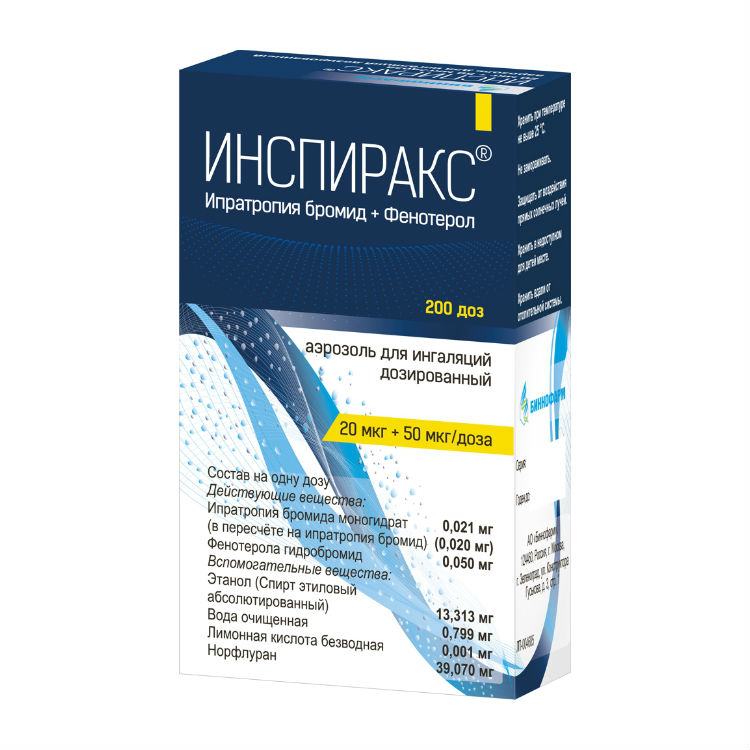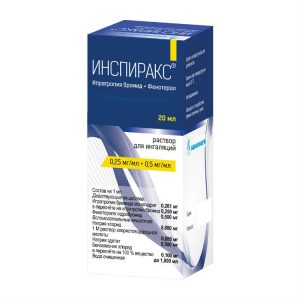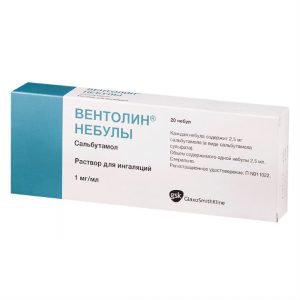Description
Pharmacological action
Combined bronchodilator. It contains two components with bronchodilator activity: ipratropium bromide – m-anticholinergic, and fenoterol hydrobromide – beta2-adrenergic agonist.
Ipratropium bromide is a quaternary ammonium derivative with anticholinergic (parasympatolytic) properties. Bronchodilation with the inhalation of ipratropium bromide is mainly due to local and not systemic anticholinergic action.
Ipratropium bromide inhibits the reflexes caused by the vagus nerve, counteracting the effects of acetylcholine, a mediator released from the ends of the vagus nerve. Anticholinergics prevent an increase in the intracellular concentration of calcium ions, which occurs due to the interaction of acetylcholine with muscarinic receptors located on the smooth muscles of the bronchi.
The release of calcium ions is mediated by a system of secondary mediators, including inositol triphosphate and diacylglycerol. Ipratropium bromide does not adversely affect mucus secretion in the respiratory tract, mucociliary clearance and gas exchange.
Fenoterol selectively stimulates 2-adrenergic receptors at a therapeutic dose. Stimulation of 1-adrenergic receptors occurs with the use of phenoterol in high doses. Fenoterol relaxes the smooth muscles of the bronchi and blood vessels and counteracts the development of bronchospastic reactions due to the effects of histamine, methacholine, cold air and allergens (immediate hypersensitivity reactions).
Immediately after administration, fenoterol blocks the release of inflammatory mediators and bronchial obstruction from mast cells. Moreover, when phenoterol was used in higher doses, an increase in mucociliary clearance was noted.
The effect of the drug on cardiac activity, such as an increase in the frequency and strength of heart contractions, is due to the vascular effect of phenoterol, stimulation of 2-adrenoreceptors of the heart, and when used in doses exceeding therapeutic, stimulation of 1-adrenoreceptors. As with other beta-adrenergic drugs, the QTc interval was prolonged when used in high doses.
Tremor is the most common undesirable effect when using -adrenoreceptor agonists. In contrast to the effect on the smooth muscles of the bronchi, tolerance can develop to the systemic influence of ОІ-adrenoreceptor agonists, however, the clinical significance of this manifestation has not been elucidated.
With the combined use of ipratropium bromide and phenoterol, the bronchodilating effect is achieved by exposure to various pharmacological targets. These substances complement each other, as a result, the antispasmodic effect on the muscles of the bronchi is enhanced and a wide range of therapeutic effects is provided for bronchopulmonary diseases accompanied by airway obstruction. The complementary effect is such that to achieve the desired effect, a lower dose of the beta-adrenergic component is required, which allows you to individually choose an effective dose with almost no side effects.
In patients with bronchospasm associated with COPD (chronic bronchitis and pulmonary emphysema), a significant improvement in lung function (an increase in FEV1 and a peak expiratory flow rate of 15% or more) was noted within 15 minutes, the maximum effect was achieved after 1-2 hours and continued in most patients up to 6 hours after administration.
Pharmacokinetics
The therapeutic effect of the combination of ipratropium bromide and phenoterol hydrobromide is a consequence of local action in the respiratory tract. There is no evidence that the pharmacokinetics of the combined drug is different from that of each of the individual components.
Ipratropium bromide
With the inhalation route of administration, ipratropium bromide is characterized by extremely low absorption from the mucous membrane of the respiratory tract. The concentration of the active substance in the plasma is at the lower boundary of the determination, and it can only be measured with high doses of the active substance. After inhalation, 10-30% of the administered dose of the drug usually gets into the lungs (depending on the dosage form and method of inhalation). Most of the dose is swallowed and enters the digestive tract. The part of the dose that reaches the lungs quickly reaches the systemic circulation (within a few minutes). The total systemic bioavailability of ipratropium bromide, used by inhalation, is 7-28%.
Being a derivative of quaternary nitrogen, it is poorly soluble in fats and weakly penetrates biological membranes. Does not cumulate. Ipratropium bromide binds to plasma proteins to a minimum extent (less than 20%).
Metabolized in the liver. Up to 8 ipratropium metabolites are known, which weakly bind to muscarinic receptors. It is excreted mainly through the intestines, as well as by the kidneys. About 25% is excreted unchanged, the rest is in the form of numerous metabolites.
Phenoterol
Depending on the method of inhalation and the inhalation system used, about 10-30% of the active substance reaches the lower respiratory tract, the rest is deposited in the upper respiratory tract and is swallowed. As a result, a certain amount of inhaled phenoterol enters the gastrointestinal tract.
Absorption is biphasic – 30% of phenoterol is rapidly absorbed with T1 / 2 for 11 minutes, 70% is absorbed slowly with T1 / 2 for 120 minutes. There is no correlation between plasma concentrations of phenoterol achieved after inhalation and AUC. The long-lasting bronchodilating effect of the drug after inhalation, comparable to the corresponding effect achieved after iv administration, is not supported by high concentrations of the active substance in the systemic circulation. After oral administration, about 60% of phenoterol is absorbed. The time to reach Cmax in blood plasma is 2 hours.
Plasma protein binding of 40-55%. Fenoterol in unchanged form crosses the placental barrier and is excreted in breast milk.
Metabolized in the liver. After 24 hours, 60% of the iv dose and 35% of the oral dose are excreted in the urine. This fraction of the active substance undergoes biotransformation due to the effect of the first passage through the liver, as a result of which the bioavailability of the drug after oral administration drops to approximately 1.5%.
This explains the fact that the swallowed amount of the drug has almost no effect on the level of the active substance in the blood plasma achieved after inhalation. The biotransformation of phenoterol in humans proceeds primarily by conjugation with sulfates in the intestinal wall.
It is excreted by the kidneys and with bile in the form of inactive sulfate conjugates. With parenteral administration, fenoterol is derived, respectively, in a three-phase model with T1 / 2 – 0.42 min, 14.3 min and 3.2 hours
Indications
Prevention and symptomatic treatment of obstructive airways diseases with reversible airway obstruction, such as bronchial asthma and especially COPD, chronic bronchitis with or without pulmonary emphysema.
Contraindications
Hypertrophic obstructive cardiomyopathy tachyarrhythmias I and III trimesters of pregnancy children under 6 years of age (aerosol for inhalation) increased sensitivity to fenoterol and other components of the drug increased sensitivity to atropine-like drugs.
Precautions: angle-closure glaucoma, arterial hypertension, diabetes mellitus, recent myocardial infarction (within the last 3 months), heart and vascular diseases (chronic heart failure, CHD, arrhythmia, aortic stenosis, severe cerebral and peripheral arterial lesions), hyperthyroidism pheochromocytoma, prostatic hyperplasia, bladder neck obstruction, cystic fibrosis, II trimester of pregnancy, lactation, childhood and adolescence from 6 to 18 years (aerosol for inhalation).
Special instructions
The patient should be informed that in case of sudden rapid intensification of shortness of breath (shortness of breath), consult a doctor immediately.
Paradoxical bronchospasm
The drug can cause paradoxical bronchospasm, which can be life threatening. In the case of the development of paradoxical bronchospasm, the use of the drug should be stopped immediately and switch to alternative therapy.
Long-term use of
In patients with bronchial asthma, the drug should be used only as needed. In patients with mild COPD, symptomatic treatment may be preferable to regular use.
In patients with bronchial asthma, one should be aware of the need to conduct or strengthen anti-inflammatory therapy to control the inflammatory process of the respiratory tract and the course of the disease.
Regular use of increasing doses of drugs containing beta2-adrenergic agonists to relieve bronchial obstruction can cause an uncontrolled worsening of the disease. In the case of increased bronchial obstruction, an increase in the dose of beta2-agonists is more than recommended for a long time, not only not justified, but also dangerous. To prevent a life-threatening worsening of the course of the disease, consideration should be given to revising the patient’s treatment plan and adequate anti-inflammatory therapy with inhaled corticosteroids.
Other sympathomimetic bronchodilators should be prescribed simultaneously with the drug only under medical supervision.
Disorders of the organ of vision
The drug should be prescribed with caution to patients predisposed to the development of angle-closure glaucoma. There are separate reports of complications from the organ of vision (for example, increased intraocular pressure, mydriasis, angle-closure glaucoma, eye pain) that developed when inhaled ipratropium bromide (or ipratropium bromide in combination with 2-adrenoreceptor agonists) gets into the eyes. Symptoms of acute angle-closure glaucoma may be pain or discomfort in the eyes, blurred vision, the appearance of a halo in objects and colored spots in front of the eyes in combination with corneal edema and redness of the eyes due to conjunctival injection of blood vessels. If any combination of these symptoms is noted, the use of eye drops that reduce intraocular pressure is indicated, and immediate consultation with a specialist. Patients should be instructed on the proper use of the inhalation solution. To prevent the solution from getting into the eyes, it is recommended that the solution used with a nebulizer be inhaled through the mouthpiece. In the absence of a mouthpiece, a mask should be used that fits close to the face. Particular care should be taken to protect the eyes of patients predisposed to the development of glaucoma.
Systemic effects of
In diseases such as recent myocardial infarction, diabetes with inadequate glycemic control, severe organic heart and vascular disease, hyperthyroidism, pheochromocytoma, or urethral obstruction (e.g. with prostatic hyperplasia or obstruction of the bladder neck), the drug should be prescribed only after a thorough assessment of the risk / benefit ratio, especially when used in doses exceeding the recommended ones.
Effect on the cardiovascular system
Post-marketing studies have reported rare cases of myocardial ischemia when taking -adrenoreceptor agonists. Patients with concomitant serious heart diseases (e.g., coronary heart disease, arrhythmias, or severe heart failure) receiving the drug should be warned about the need to see a doctor in case of pain in the heart or other symptoms indicating worsening heart disease. Symptoms such as shortness of breath and chest pain should be noted. they can be both cardiac and pulmonary etiology.
Hypokalemia
Hypokalemia may occur with 2-adrenoreceptor agonists.
In athletes, the use of the drug, due to the presence of phenoterol in its composition, can lead to positive results of doping tests.
Excipients
The preparation in the form of an aerosol for inhalation contains a preservative, benzalkonium chloride, and a stabilizer – disodium edetate dihydrate. During inhalation, these components can cause bronchospasm in sensitive patients with airway hyperresponsiveness.
Effect on the ability to drive vehicles and mechanisms
The effect of the drug on the ability to drive vehicles and use mechanisms has not been specifically studied. However, patients must be informed that during treatment with the drug, the development of such adverse events is possible, like dizziness, tremor, disturbance of accommodation, mydriasis, blurred vision. Therefore, caution should be recommended when driving or using machinery. If patients experience the above unwanted sensations, you should refrain from such potentially dangerous actions as driving vehicles or operating machinery.
Composition
Dosage inhalation aerosol is colorless or light yellow or light brown. or with a brownish-yellowish tint, a clear solution with the smell of ethanol, which is under pressure in a metal monoblock container with a metering valve, equipped with an inhaler nozzle with a protective cap, the drug is sprayed in the form of an aerosol cloud when leaving the cylinder.
1 dose
ipratropium bromide monohydrate 0.021 mg,
which corresponds to ipratropium bromide 0.02 mg
phenoterol hydrobromide 0.05 mg
Excipients:
ethanol (absolute alcohol free sludge, mg13 – srdl – 300 mg srldl – 300 mg) 0.001 mg,
hydrofluoroalkane (HFA-134a) – 39.07 mg.
Side effects
The frequency of adverse reactions was determined in accordance with WHO recommendations: very often (> 1/10) often (> 1/100, < 1/10) infrequently (> 1/1000, <1/100) rarely (> 1/10 000, <1/1000) very rarely (<1/10 000), including individual messages, frequency is unknown (frequency cannot be counted according to available data). On the part of the immune system: rarely – hypersensitivity reactions, anaphylactic reactions. From the side of metabolism and nutrition: rarely – hypokalemia, metabolic acidosis. Mental disorders: infrequently – nervousness rarely – a sense of anxiety, mental disturbances. From the nervous system: infrequently – headache, dizziness, tremor. From the side of the organ of vision: rarely – glaucoma, increased intraocular pressure, impaired accommodation, mydriasis, blurred vision, eye pain, corneal edema, conjunctival hyperemia, the appearance of a halo around objects and colored spots in front of the eyes. From the cardiovascular system: infrequently – tachycardia, palpitations, increased systolic blood pressure rarely – arrhythmia, atrial fibrillation, supraventricular tachycardia, myocardial ischemia, increased diastolic blood pressure. From the respiratory system: often – cough infrequently – pharyngitis, dysphonia rarely – bronchospasm, pharyngeal irritation, pharyngeal edema, laryngospasm, paradoxical bronchospasm, dry throat. From the digestive system: infrequently – vomiting, dry mouth, nausea rarely – stomatitis, glossitis, gastrointestinal motility, constipation, diarrhea, swelling of the oral cavity. Dermatological reactions: rarely – urticaria, skin rash, pruritus, angioedema, hyperhidrosis. From the musculoskeletal system: rarely – muscle weakness, myalgia, muscle spasm. From the urinary system: rarely – urinary retention. Terms of delivery from pharmacies Prescription dosage form aerosol for inhalation




